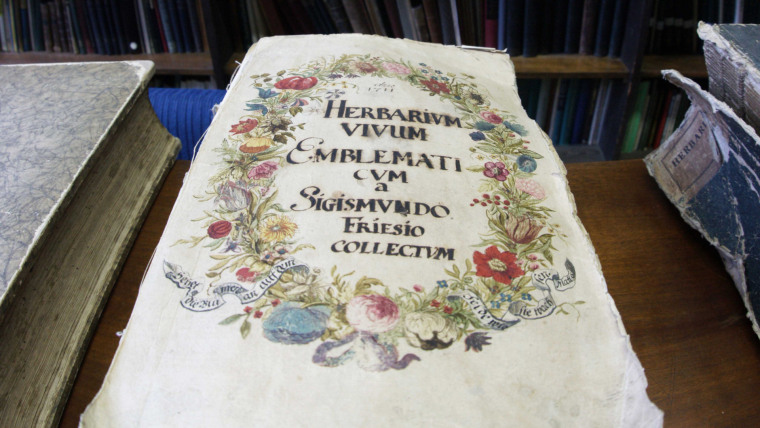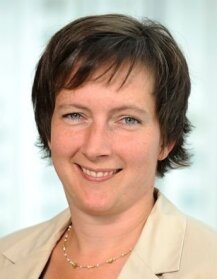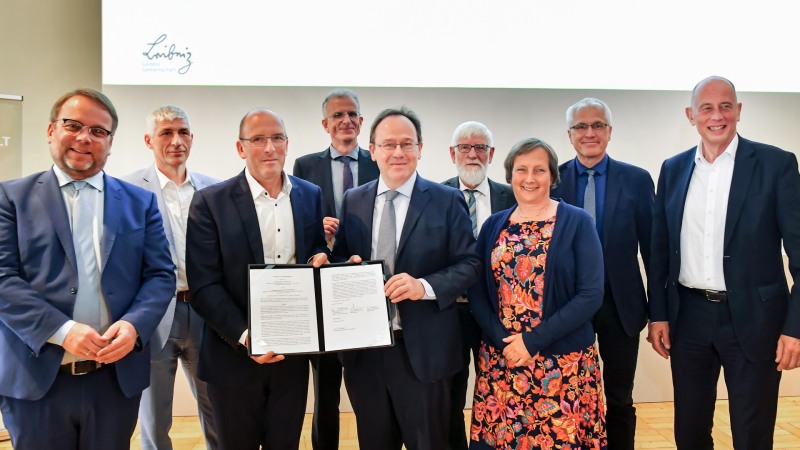
- Research
Published: | By: Judith Jördens
The Senckenberg Institute for Plant Form and Function at the Friedrich Schiller University Jena was founded in a festive ceremony today. In the presence of Wolfgang Tiefensee, Minister for Economic Affairs, Science and Digital Society in Thuringia, and Timon Gremmels, Hessian State Minister for Higher Education, Research, Science and the Arts, the institute was accepted into the Leibniz Association as part of Senckenberg.
Among other things, the new institute houses the Herbarium Haussknecht – one of the most important European collections of plants with around 3.5 million specimens. The Federal Minister of Education and Research, Bettina Stark-Watzinger, congratulated the new institute in a video message and emphasized that "Germany as a centre of science will also benefit from the new foundation".
Plants play an indispensable role in ecosystems worldwide. They form the basis of life by producing oxygen, binding carbon dioxide and creating habitats and food for numerous creatures. Without plants, the balance of nature, ecosystems and the climate as we know it would not exist. In addition, plants are invaluable to us humans as food and a source of Medicine and raw materials.
"Jena is a stronghold of biodiversity research. The new Senckenberg Institute fits in perfectly with this scientific tradition and the existing research environment. The Herbarium Haussknecht alone is a collection of inestimable value. Its scientific usability will be significantly enhanced by the co-operation with Senckenberg. Conversely, the international visibility and importance of biodiversity research in Jena will be significantly strengthened by the establishment of this new institute. As a state, we are therefore also providing considerable financial support for the project," says Thuringia's Science Minister Wolfgang Tiefensee.
At the eighth Senckenberg Institute in Jena, biodiversity change in the Anthropocene – the age shaped by humans – will be comprehensively analysed in temporal depth and spatial breadth using modern and innovative methods. The professorships of Integrative Taxonomy of Plants and Functional Biodiversity of Plants already established at the University of Jena, together with two new Senckenberg professorships of Ecology and Evolution of Mosses and Digital Collectomics, will in future use the collections of the Jena Herbarium for their research into biodiversity change.
Optimal conditions for collection-based research
Prof. Dr Georg Pohnert, Interim President of the Friedrich Schiller University Jena, is delighted: "Jena offers optimal conditions for new collection-based research and teaching: the Senckenberg Institute will be embedded in the innovative research landscape in Jena. Research areas at our University, in which ecology, evolution and biodiversity are researched, form a perfect environment for the new institution.
The Institute of Computer Science and the German Centre for Integrative Biodiversity Research (iDiv) Halle-Jena-Leipzig also contribute to the integration of the new activities. There are also extensive links and collaborations with the Balance of the Microverse Cluster of Excellence and non-university research institutes such as the Max Planck Institute for Biogeochemistry, the MPI for Chemical Ecology and the MPI for Geoanthropology."
With 3.5 million specimens, the Herbarium Haussknecht is one of the most important herbaria in Europe and is also the largest regional botanical collection in Germany. "The collection is a great treasure that holds potential for various research questions," explains Prof. Dr Christine Römermann, Head of the Senckenberg Institute of Plant Form and Function Jena, and continues: "Through digitalization combined with imaging and the inclusion of artificial intelligence and deep learning, through the integration of databases, and through the application of molecular genetic methods, the extensive potential of this unique collection for the analysis of biodiversity change can now be raised and shared."
Römermann and her team plan to reconstruct biodiversity and its changes and interactions in a spatially explicit manner and over a period of the last century. The researchers in Jena also plan to develop forecasts and options for action for the conservation of biodiversity in the future.
"The now eighth Senckenberg Institute is part of our strategic expansion project 'Anthropocene Biodiversity Loss'. It will enable us to consistently develop and deepen our systemic approach to geobiodiversity research – the study of the diversity of life with its numerous interactions in the Earth system – in close cooperation with local partner institutions. In order to meet the most pressing challenges of our time – the twin crises of biodiversity loss and climate change – it is essential to transform data and information into knowledge and ultimately into options for action.
Our collections – which now also include the impressive Herbarium Haussknecht – are irreplaceable archives of nature. As part of the expansion project, we can develop these into digital research platforms and link collection data with global data on the Earth system. As part of the Leibniz Association, Senckenberg is thus assuming responsibility for people and nature for future generations. I would like to express my sincere thanks to all participants and supporters and am extremely pleased about the new institute in our Senckenberg family," concludes Prof. Dr Klement Tockner, Director General of the Senckenberg – Leibniz Institution for Biodiversity and Earth System Research.
Timon Gremmels, Dr Thoralf Held, Prof. Georg Pohnert, Prof. Karsten Wesche, Prof. Klement Tockner, Prof. Frank Hellwig, Prof. Christine Römermann, Prof. Axel Brakhage and Wolfgang Tiefensee (from left to right) at the founding of the Senckenberg Institute for Plant Form and Function on 10 June 2024 in the assemby hall of Friedrich Schiller University Jena.
Image: Jürgen Scheere (University of Jena)
